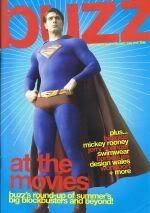Shadow: Dead Riot (2006)
Any film starring horror legend Tony Todd as a sadistic, blood-drinking, baby-eating undead murderer is off to an extremely promising start. So when Shadow: Dead Riot turns out to just be a reasonably competent zombie B-movie, it’s hard not to be just a little bit disappointed.
Basically, once upon a time, a big scary guy with pointy teeth was sentenced to death as a result of his murdering ways. “Going out with a bang” has never been so literal, as Shadow explodes in the chair, sending tendrils of CGI blood winding their way through the prison and causing a riot. The dead prisoners (and remaining bits of Shadow) are all dumped in a mass unmarked grave and forgotten about. Fast-forward twenty years, and the grotty prison has become an even grottier “Experimental Rehabilitation Centre for Women.” (And it really should be pointed out that this is a somewhat lazy move on the part of the filmmakers: alright, you wanted to communicate that this place is slightly out of the ordinary, but surely no real facility would so readily broadcast its “experimental” status.)
Anyway, the theory goes that female murderers and bank robbers can be fixed with a diet and exercise plan. Which sounds just about hippie enough for such an “experimental” facility, but apart from a poorly-positioned aromatherapy room and some questionable vitamin injections, it’s difficult to see how this differs from any other plain old prison: the blood-stained walls and rusty bars certainly don’t inspire much confidence in their methods. Our heroine goes by the name of Solitaire, an alias she’ll provide three different explanations for throughout the course of the film; her real name is Cassandra, which may be a reference to her apparent psychic powers, or someone may just have thought it sounded pretty. Despite having done something criminal enough to land her in jail, she’s also, necessarily, a good person, with, handily, some pretty decent leadership skills.
What follows is mostly a series of standard prison-type escapades, including some incredibly badly choreographed fight scenes, and repulsive lesbian wardens. There’s also an entirely gratuitous shower scene featuring many, many bare breasts. It takes roughly 37 minutes for the first zombie to show up, and even then it’s a while before the real undead action gets going. When it does, it’s a slightly off-balance mixture of gore and hilarity – which is not altogether a bad thing, as there are some genuinely inspired moments: those that stand out include a zombie hand grabbing an umbilical cord after the world’s fastest birth, and a zombie using his dangling eyeball to spot a hiding victim.
Once most of the girls have been killed off (some managing to let their clothes fall off just as they’re getting mangled), it’s finally time for the inevitable showdown between Shadow and Solitaire. Unfortunately, the resulting fight looks like an outtake from a Buffy the Vampire Slayer episode, at least in part due to the number of times Solitaire is thrown up against a wall. Considering that the whole film has been leading up to this moment, it’s very anticlimactic, and ridden with impracticalities. This really is the worst prison ever, considering how easy it is to smuggle illegal objects inside, but presumably the staff were too busy screwing the inmates to worry about things like that. The Darth Vader “revelation” was actually revealed a lot earlier in the movie, and is also glaringly obvious due to the skin colour of the two leads. Which is a problematic statement, though it could be read that Shadow: Dead Riot is making a valid sociological point by showing a prison full of black people, run by white people – but this is a zombie movie, not a social commentary, and similarly, this is a film review and not an analysis of crime statistics. Since it’s also entirely likely someone just wanted to cast Tony Todd and therefore needed to cast a black girl as Solitaire, it’s probably not worth delving any further into the issue.
From a more technical perspective, there’s something odd about the colours of this movie: they’re all washed out, though whether this is a stylistic choice or just a slightly mangled transfer is debateable. Shadow’s voice sounds like it’s coming through a distant synthesizer, which is careless considering this is Tony Todd, a man more than qualified to provide a creepy voice all by himself. There’re a few sloppy continuity errors, and the scripting is occasionally rather heavy-handed – it can’t be possible to find anyone who would say, in all seriousness, “behind this beauty lies your destruction” unless they happened to a Buffy villain, and there are some conversations that just completely fail to make sense.
With all that said, it’s not a complete waste of time. Once the zombies have made an appearance, it’s an enjoyably straightforward race to the finish, and some of the scenes thrown in along the way must rank amongst the most repulsive ever created. The zombie baby is truly gruesome, demonstrating the dangers of breastfeeding in a particularly hideous moment that’ll stick with you long after the movie’s finished. Tony Todd’s not the only horror legend to make an appearance, as the credits reveal some pretty darned impressive guest zombies (and a certain “Erin Brown”, whose screen time is cut disappointingly short), so while it’s obviously complete and utter nonsense, it’s also somehow, against all odds, compulsive viewing, if only for indulging in the time-honoured sport of homage-spotting. It’s not hard to imagine this sneakily becoming a cult classic.
IMDB link










No comments:
Post a Comment